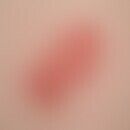Synonym(s)
HistoryThis section has been translated automatically.
Castellani, 1910
DefinitionThis section has been translated automatically.
Bacterial, non-inflammatory infection of the sole of the foot with swelling of the horny layer, shallow dimpled (pitted), corneal defects, which occur mainly in the mechanically stressed areas.
Athletes and soldiers who wear occlusive footwear for extended periods of time, or barefoot people who sweat heavily and spend time on wet surfaces, such as laborers, farmers, and sailors, are more susceptible to this problem. Martial artists are at greater risk for skin infections due to constant physical contact that can lead to transmission of viral, bacterial, and fungal pathogens, directly, but also indirectly through contact with infected sports mats and the skin flora of another infected person (Balić A et al. 2018).
Particularly frequent occurrence of the infection in tropical and subtropical zones.
You might also be interested in
PathogenThis section has been translated automatically.
The manifestations of PK are due to superficial cutaneous infection caused by various bacterial gram-positive species, including:
Corynebacterium species
Kytococcus sedentarius
Dermatophilus congolensis
Actynomices keratolytica and
Streptomyces
which proliferate under suitable humid conditions and produce proteinases and sulfur compounds as byproducts (Balić A et al. 2018). Proteinases digest keratin and destroy the stratum corneum, resulting in the characteristic skin finding, while sulfur compounds (sulfides, thiols, and thioesters) are responsible for the foul odor.V.a. Kytococcus sedentarius, corynebacteria, Dermatophilus congolensis, Actinomyces spp.
EtiopathogenesisThis section has been translated automatically.
The manifestations of "Pitted keratolysis" (PK) are due to a superficial cutaneous infection caused by various bacterial Gram-positive species, including:
- Corynebacterium species
- Kytococcus sedentarius
- Dermatophilus congolensis
- Actynomices keratolytica and
- Streptomyces.
These pathogens can multiply under suitable humid conditions. They produce proteinases and sulfur compounds as byproducts (Balić A et al. 2018). Proteinases digest the keratin and destroy the stratum corneum, resulting in the characteristic skin findings, while sulfur compounds (sulfides, thiols, and thioesters) are responsible for the characteristic, albeit foul, odor.This is especially true for Kytococcus sedentarius, Korynebacteria, Dermatophilus congolensis, and Actinomyces spp.
ManifestationThis section has been translated automatically.
Worldwide distribution, frequently found in youthful sneaker wearers. People > 50 years are very rarely affected.
LocalizationThis section has been translated automatically.
Predilection sites are soles of the feet, especially heel, ball of big toe, lateral parts of the sole.
Clinical featuresThis section has been translated automatically.
Mostly challenging, penetrating odor of the "sweaty foot" (bromhidrosis) with pronounced hyperhidrosis. Characteristic is a whitish swollen horny layer with interspersed dimple-shaped, 0.1-0.3 cm large flat horny layer defects (pits) that appear as if punched out, which can confluence to form 1.0-3.0 -5.0 cm large, shallow, usually circularly limited depressions. Usually no tenderness on pressure. Sometimes, however, burning, stabbing pain is complained of during walking.
HistologyThis section has been translated automatically.
Circumscribed defects in the stratum corneum. PAS: no evidence of mycelia!
TherapyThis section has been translated automatically.
External therapyThis section has been translated automatically.
Careful daily foot washing or foot baths with disinfectant solutions (e.g. chlorhexidine solution 0.2%), soaps or syndets.
Alternative: Topical solutions containing erythromycin, clindamycin or clotrimazole.
General indications:
- Change stockings daily, no occluding footwear, wear breathable shoes.
- Use of antiperspirants containing methenamine (e.g. Antihydral ointment) or aluminium chloride hexahydrate R005 or R006 as well as perfumed or unscented deodorants to mask unpleasant foot odour.
Progression/forecastThis section has been translated automatically.
Note(s)This section has been translated automatically.
The clinical combination of Trichobacteriosis axillaris with Keratoma sulcatum and Erythrasma is not very rare.
LiteratureThis section has been translated automatically.
- Balić A et al. (2018) Tatami Mats: A Source of Pitted Keratolysis in a Martial Arts Athlete? Acta Dermatovenerol Croat 26: 68-70.
- Castellani A (1910) Keratoma plantare sulcatum. J Ceylon Br Med Assoc 1: 12-14.
- Lee HJ et al (1999) Pitted keratolysis of the palm arising after herpes zoster. Br J Dermatol 140: 974-975
- Longshaw CM et al (2002) Kytococcus sedentarius, the organism associated with pitted keratolysis, produces two keratin-degrading enzymes. J Appl Microbiol 93: 810-816
- Rho NK et al (2008) A corynebacterial triad: prevalence of erythrasma and trichomycosis axillaris in soldiers with pitted keratolysis. J Am Acad Dermatol 58 (2 Suppl):S57-558
- Takama H et al (1997) Pitted keratolysis: clinical manifestations in 53 cases. Br J Dermatol 137: 282-285
- van der Snoek EM et al. (2013) Pitted keratolysis; physicians' treatment and their perceptions in Dutch army
- personnel.J Eur Acad Dermatol Venereol 27:1120-1126
- Wohlrab J et al (2000) Keratolysis sulcata (pitted keratolysis): clinical symptoms with different histological correlates. Br J Dermatol 143: 1348-1349
- Zaias N et al (1965) Pitted keratolysis. Arch Dermatol 92: 151-154
Incoming links (14)
Aluminium chloride hexahydrate solution, 15/20% 2-propanol (nrf 11.1.); Aluminium chloride hexahydrate solution, viscose, hydrophilic 15/20% (nrf 11.132.); Axillary trichobacteriosis; Castellani, aldo; Chlorhexidine solution 0,2%; Corynebacteria; Corynebacterium; Erythrasma; Keratolyses, dimpled; Keratolysis, pitted; ... Show allOutgoing links (10)
Aluminium chloride hexahydrate; Aluminium chloride hexahydrate solution, 15/20% 2-propanol (nrf 11.1.); Aluminium chloride hexahydrate solution, viscose, hydrophilic 15/20% (nrf 11.132.); Axillary trichobacteriosis; Bromhidrosis; Castellani, aldo; Chlorhexidine solution 0,2%; Corynebacteria; Erythrasma; Hyperhidrosis (overview);Disclaimer
Please ask your physician for a reliable diagnosis. This website is only meant as a reference.











